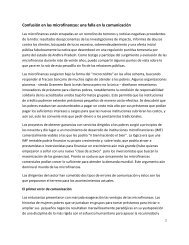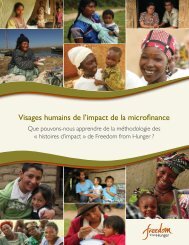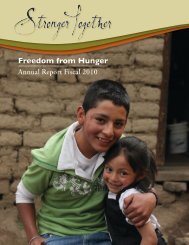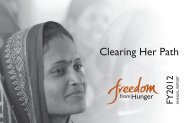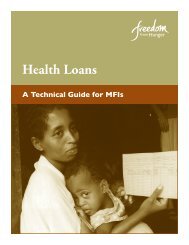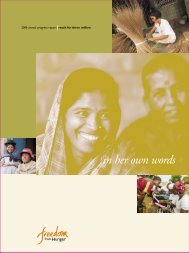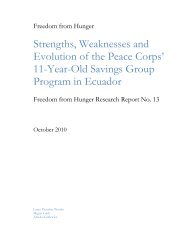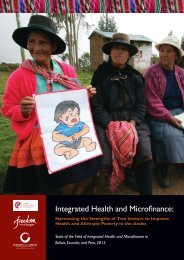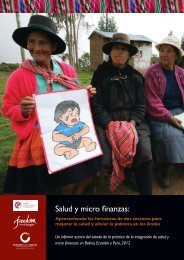history of meals for millions, soy, and freedom from ... - SoyInfo Center
history of meals for millions, soy, and freedom from ... - SoyInfo Center
history of meals for millions, soy, and freedom from ... - SoyInfo Center
Create successful ePaper yourself
Turn your PDF publications into a flip-book with our unique Google optimized e-Paper software.
eginning <strong>of</strong> that story is really about Clif<strong>for</strong>d Clinton, who<br />
was the son <strong>of</strong> missionary parents. In “China, as a child, he<br />
had seen famine, <strong>and</strong> he’d made a boyhood resolve that if<br />
he could ever do anything about helping hungry people, he<br />
would. So it was not surprising that when he grew up he<br />
went into the restaurant business.” During the depression,<br />
starting in 1931, “he advertised that anyone who came to his<br />
cafeteria between 2:00 <strong>and</strong> 4:00 [in the afternoon] could get<br />
a free meal.” Later he felt the <strong>of</strong>fer was being taken<br />
advantage <strong>of</strong>, “so he charged a nickel <strong>for</strong> a meal. The last<br />
time I ate there, which was more than ten years ago, the<br />
menu said, ‘You can order what you like–<strong>and</strong> you can pay<br />
what you like.’<br />
“When the war came, with the enormous expansion <strong>of</strong><br />
the armed <strong>for</strong>ces <strong>from</strong> a couple <strong>of</strong> hundred thous<strong>and</strong> to<br />
twelve million, the army needed advice on how to feed a lot<br />
<strong>of</strong> people in camps quickly. And so they called in<br />
consultants <strong>from</strong> the restaurant business, <strong>and</strong> Clinton was<br />
one <strong>of</strong> those consultants.<br />
“Then, one afternoon in early 1945–he’d phoned first–<br />
he <strong>and</strong> his wife <strong>and</strong> his public relations man [Ernest<br />
Chamberlain] came to see me. And be<strong>for</strong>e he began to talk<br />
his wife intervened <strong>and</strong> said, ‘I want to apologize because<br />
my husb<strong>and</strong> is coming here with a perfectly ridiculous<br />
proposal. I tried to dissuade him <strong>from</strong> coming but he’s very<br />
stubborn, <strong>and</strong> so I want you to know that I feel a bit<br />
ashamed.’ So I said, ‘Well, you needn’t be. You’re here.<br />
Make yourselves com<strong>for</strong>table <strong>and</strong> let’s listen.’<br />
“So Clinton began to talk, <strong>and</strong> he said that anybody<br />
who thought about it could see the war coming to an end,<br />
that in the countries where the war had been going on a lot<br />
<strong>of</strong> people were going to be hungry, <strong>and</strong> that there was going<br />
to be a shortage <strong>of</strong> food in Europe <strong>and</strong> Asia, <strong>and</strong> he wanted<br />
to do something about it. And he said he wanted me to do<br />
this–I was to devise a food where a meal would provide<br />
one-third <strong>of</strong> the Recommended Daily Allowances <strong>of</strong><br />
everything, but it was to weigh not more than two ounces<br />
<strong>and</strong> it was to cost not more than three cents, it was not to<br />
<strong>of</strong>fend any religious taboo, there should be an abundant<br />
supply <strong>of</strong> all the ingredients, <strong>and</strong> it wouldn’t draw on the<br />
kinds <strong>of</strong> food Americans are accustomed to eat. (I said, ‘You<br />
needn’t worry–at that price.”). Also it had to have an<br />
indefinite shelf life, be possible to eat in a variety <strong>of</strong> ways,<br />
<strong>and</strong> not take any special equipment to cook–a can <strong>of</strong> water<br />
<strong>and</strong> a stick <strong>of</strong> wood underneath should do it.<br />
“And so we went on. I turned to his wife <strong>and</strong> I said,<br />
‘Well, it’s not so wild as you may think, but there are two<br />
restrictions I would put on it. It’s scientifically impossible to<br />
provide a third <strong>of</strong> the Recommended Daily Allowances in<br />
two ounces <strong>of</strong> anything. It is just not possible. We need<br />
about 700 or 800 calories as a minimum, <strong>and</strong> the most that<br />
two ounces would supply would be about 140 or 150<br />
calories.’ Secondly, I said, “I don’t think it would be<br />
practical to put vitamin C in because we really don’t know<br />
MEALS FOR MILLIONS, SOY, AND FREEDOM FROM HUNGER 123<br />
© Copyright Soyinfo <strong>Center</strong> 2011<br />
how to keep it.’ At that time we didn’t. But I said,<br />
‘Otherwise we could provide protein that’s as good as meat<br />
or milk, <strong>and</strong> we could add all the vitamins <strong>and</strong> minerals that<br />
they need in two ounces, <strong>and</strong> I don’t think it need cost more<br />
than about 3 cents a meal.’ So he agreed <strong>and</strong> gave Caltech<br />
the sum <strong>of</strong> $5,000, which I was to use to develop this food.<br />
“The food itself was no problem. I had a pretty good<br />
idea how to do it. It had to be a vegetable protein; animal<br />
proteins were too dear [expensive]. The best vegetable<br />
protein was <strong>soy</strong>bean protein, <strong>and</strong> I knew that during the war<br />
we–the government–had greatly exp<strong>and</strong>ed the growth <strong>of</strong><br />
<strong>soy</strong>beans <strong>for</strong> their oil. But after the oil was extracted, what<br />
was left over [the cake or meal] was thrown down the<br />
sewer. It was just wasted. So I knew this would be very<br />
cheap, <strong>and</strong> I knew it was available in large quantities. The<br />
vitamins <strong>and</strong> minerals I knew were also very cheap <strong>and</strong><br />
there would be no problem about adding them.<br />
“What I wanted the money <strong>for</strong> was to hire a cook who<br />
could develop recipes on how to use the food, how it should<br />
be cooked in different ways. And that was done. At the end<br />
<strong>of</strong> a year it was all ready, <strong>and</strong> we had a whole lot <strong>of</strong> recipes.<br />
One <strong>of</strong> the fruit <strong>and</strong> vegetable dehydrator companies in Los<br />
Angeles undertook to make it according to the recipe I had<br />
drawn up, <strong>and</strong> that was done. We decided to call it<br />
‘multipurpose food’: MPF.<br />
“Neither Clinton nor I wanted to patent this food, <strong>and</strong><br />
we agreed that we would give the in<strong>for</strong>mation to anybody<br />
who asked <strong>for</strong> it. But that wasn’t going to get the food to<br />
hungry people, so Clinton, who was a religious man, set up<br />
this Meals <strong>for</strong> Millions Foundation, a nonpr<strong>of</strong>it<br />
organization. I was one <strong>of</strong> the c<strong>of</strong>ounders with two or three<br />
others. He hired a woman by the name <strong>of</strong> Florence Rose <strong>and</strong><br />
his publicity man, Ernest Chamberlain, was the other, who<br />
really were the foundation. They sent out the appeals <strong>for</strong><br />
money, they raised the money, bought the food, <strong>and</strong> so on.<br />
MT: “So they raised the money <strong>from</strong> other sources. It<br />
wasn’t just his money?<br />
HB: “No, I don’t think he put in much money after that,<br />
but it was certainly his idea, both to get such a food <strong>and</strong><br />
then to set up the Foundation to give the food to people who<br />
needed it. And I know that when we had the food ready we<br />
thought it would be useful if the Food <strong>and</strong> Nutrition Board<br />
[<strong>of</strong> the National Academy <strong>of</strong> Sciences] would approve <strong>of</strong> it.<br />
We sent some to them, <strong>and</strong> they said, ‘No, we believe that a<br />
good diet consists <strong>of</strong> meat, milk, fresh fruit, fresh<br />
vegetables, <strong>and</strong> this is not that.’ So <strong>for</strong> more than ten years<br />
[1946-1956], we had no government support–in fact,<br />
government opposition. So the money was raised <strong>from</strong><br />
private groups. Two large charitable organizations very soon<br />
began to give us large sums <strong>of</strong> money–$50,000 to $100,000<br />
at a time–<strong>and</strong> we would send the food where they told us to.<br />
They were Catholic World Relief <strong>and</strong> Church World<br />
Service.”



